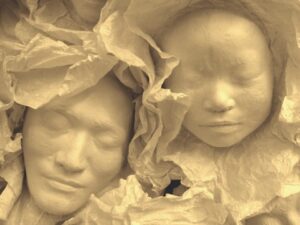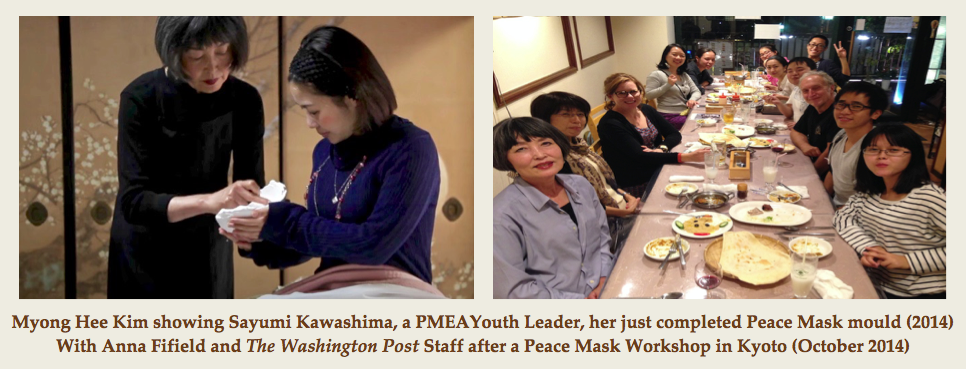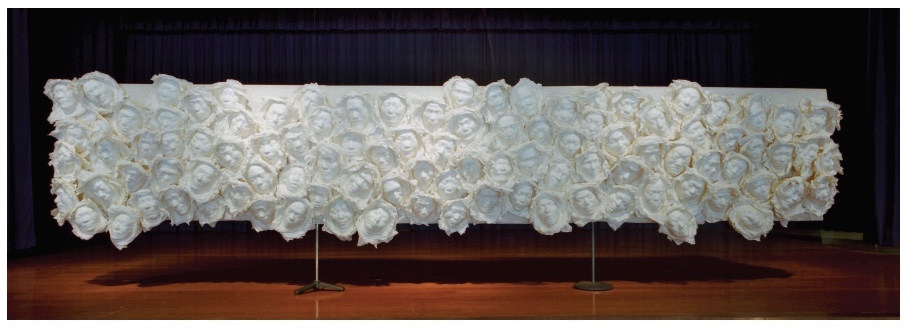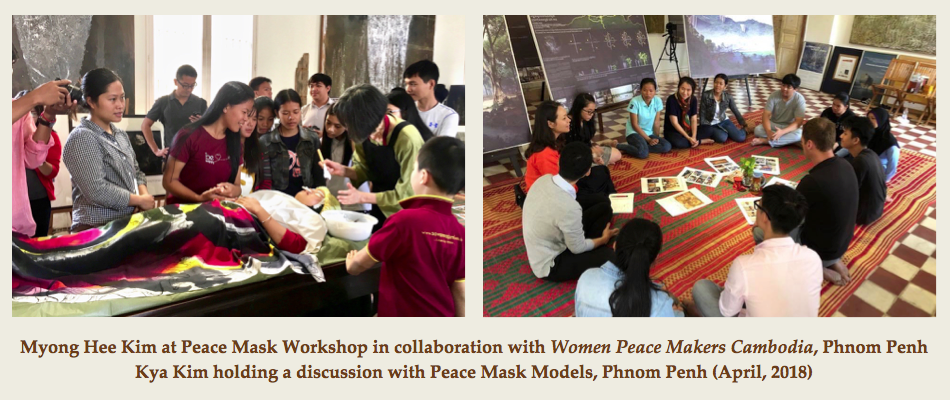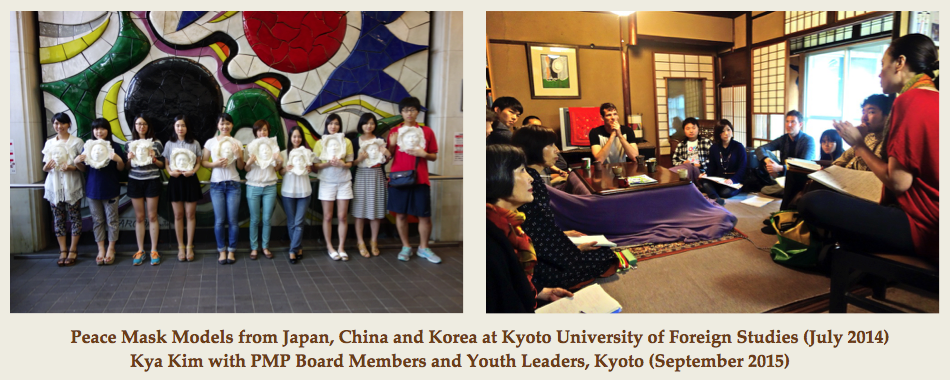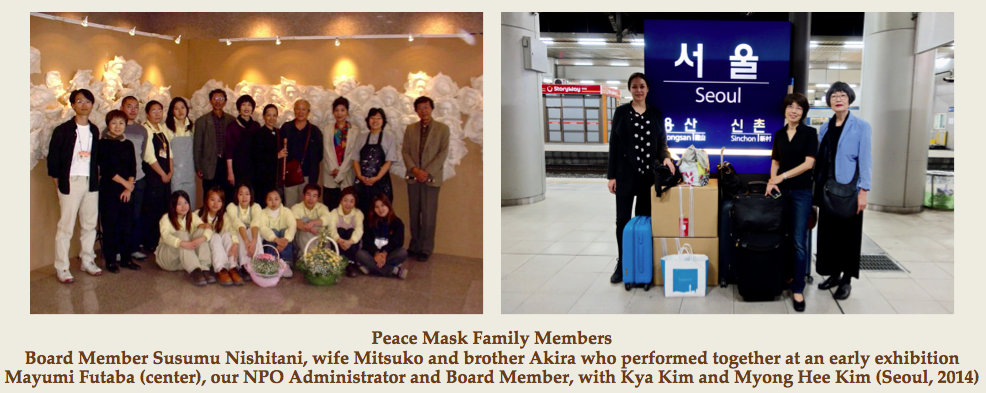Celebrating 20 Years of Peace Mask Project: An Interview with Director Kya Kim
INTERVIEW, 17 Aug 2020
Robert Kowalczyk interviews Kya Kim – TRANSCEND Media Service
Based on your personal experiences with Peace Mask Project since becoming Communications Director in 2014, what are some of your most remembered experiences?
The first memorable experience for me was speaking at TEDxKyoto at Kyoto University of Foreign Studies. I had never spoken in front of such a large audience before, so it was both challenging and exhilarating. With that talk we launched our Peace Mask East Asia (PMEA) project, bringing Japanese, Chinese, and Korean youth together at a time when tensions between the three countries were increasing and such opportunities were rare.
httpv://www.youtube.com/watch?v=2AZw_kHTkCU
With PMEA, we were invited to take part in the 8th International Conference of Museums for Peace in No Gun Ri, South Korea in September 2014, as well as at the PANAsia Conference on Jeju Island, South Korea, the following year. Two very different conferences, which showed me the potential of what we could do with Peace Mask Project and also introduced us to many inspiring individuals.
We also held a number of workshops for PMEA in Kyoto, where our NPO is based. At one such workshop, the Tokyo Bureau Chief for The Washington Post, Ms. Anna Fifield came to spend the day with us, speaking with the Youth Leaders, and getting to know our work deeply. Ms. Fifield wrote a full page article available online that has been a valued source for conveying our mission.
A dear friend, Ingmar Zahorsky, also helped us to make a video of one of our Japanese Youth Leaders Sayumi Kawashima, and the mask making process, which we have often used in our work.
Then, in August of 2015 we were invited to the History + Art = Peace Festival organized by Alpha Education in Toronto. An article about the Festival can be found online here. That was an exciting trip and we were really impressed by the team at Alpha, mainly women, who were dedicated peacebuilders with a strong conviction in the importance of social justice. We were able to learn about the perspectives of East Asians living in North America, which gave PMEA a unique and valuable insight.
One of your longest projects has been the Hibakusha Peace Mask Project (HPMP). Would you please relate some thoughts on that 17-month effort?
Throughout 2016 and early 2017, we were focused on the Hibakusha Peace Mask Project (HPMP), holding numerous workshops in Hiroshima, Nagasaki, Kyoto, and Hapchon, Korea among other locations, to make the Peace Masks of 100 atomic bomb survivors and their descendants.
It was a very intense process that made us think deeply about our own mission as a nonprofit organization. Opinions were divided as to whether it was a conflict transformation or an advocacy tool, and whether advocating for one group’s message matched our NPO’s mission. I believe this was reconciled through the emphasis on the diversity of the Hibakusha community, notably that the victims of the atomic bombs in Hiroshima and Nagasaki were not only Japanese, but many nationalities including Korean, Chinese, and American. Highlighting the fact that nuclear weapons do not discriminate based on nation or race but inflict violence upon all of humanity was very important in solidifying our purpose.
In March of 2017, we completed HPMP with a final exhibition at the Hiroshima Peace Museum and Memorial. Another significant aspect of this project was that it was made possible through a crowdfunding effort. The project would not have been possible without the many supporters that sustained the 17-month long project for which we are very grateful.
Since you became Director in 2018, Peace Mask Project has appeared in South-east Asia. Can you tell us more about that?
We were invited to Phnom Penh, Cambodia, in April 2018 by the NGO Women Peace Makers (WPM). In collaboration with WPM, we worked closely with 15 individuals from various ethnic groups in Cambodia and held numerous workshops and two exhibitions. I would say that this was one of our most vigorous and exciting collaborations.
Personally, I was very inspired by WPM’s Executive Director Suyheang Kry, who, like myself, is a dedicated student of Dr. Johan Galtung. Our values around conflict transformation and peacebuilding were very much in alignment and I was inspired by her grassroots approach and personal dedication. With my dear friend Raymond Hyma, who acted as an advisor for the project, I also learned the value of strong relationships with local organizations and partners.
We again found out that our exhibitions attract a great deal of attention from the media, and how art can be a powerful tool for amplifying stories. The exhibition became a platform for the 15 participants to tell their story to the world, which made me further realize the potential of Peace Mask Project to act as a tool for other organizations and individuals doing peacebuilding work. A publication we co-wrote with WPM is available online here. An article in the Phnom Penh Post can be read here.
Finally, of personal significance to me was to be invited by Humanitarian Affairs Asia in November 2018 to be one of the keynote speakers at the Inaugural Peace Summit of Emerging Leaders at the UN Conference Centre in Bangkok. To be able to speak about peace with the UN symbol behind me felt like a dream. That was a very challenging talk for me, especially as the delegates asked many difficult questions. It showed me where I needed to improve, both as a speaker and a peacebuilder, and helped motivate me to become a better lecturer at universities.
This was a significant event for the Hibakusha Project as well, because we were invited to hang the 100 Hibakusha Peace Masks in the conference room with the delegates throughout the Summit. A video summary of the proceedings can be viewed here.
httpv://www.youtube.com/watch?v=nkFCUCT-fkI
Which of these many varied endeavors do you see as an example of where Peace Mask Project should move forward?
Personally, I find the partnership we made with WPM in Cambodia the most compelling example of what is possible for us as we move forward. Until now we have focused mainly on the artistic endeavor of Peace Mask Project, with an emphasis on the exhibitions. While this will always be foundational to our work, the way we used the Peace Mask process to facilitate dialogue around issues of identity in Phnom Penh, as it related to the conflict transformation work WPM is doing locally, was fresh and exciting. I aim to foster continued collaboration with partner organizations and use Peace Mask workshops, dialogues, and exhibitions to support and enhance their peacebuilding efforts.
What are the current problems facing the project that need to be attended to for its future relevance and sustainability?
Our main challenge is and always has been funding. We rely entirely on volunteers, and without funding it becomes difficult to cover basic necessities for everything from materials needed for the Peace Masks, to renting spaces for our workshops, to any travel expenses that might be incurred. We also need to expand our endeavors to include more partners, including assistant artists.
How do you see these being overcome?
In terms of funding, it would of course be ideal if we had consistent funding, preferably from a foundation or institution that shares our values and mission and can appreciate our 20-year history. Once the basics are covered, we would be able to focus more on developing our conflict transformation model and have the capacity to put effort into outreach and project planning. As for strengthening the organization, our current priority is to find artists to join our team, be trained in the Peace Mask making process, and assist in the workshops.
Based on your academic studies and many varied experiences, where would you like to see the project moving in current terms of conflict resolution?
It is my hope that we can bolster our capacity as a conflict transformation tool, developing our dialogue methodology, project planning, and short/long-term impact assessment. I believe the best way to do this would be to partner with peacebuilding organizations with strong relationships in the communities that might benefit from our project.
Many peacebuilding efforts understand the value of art and symbolism in their work, but not many have artists on staff. With 20 years of experience,
I believe we have a tool that is easily adaptable and can work in a variety of cultural and environmental contexts. We have seen how the Peace Mask making workshops bring people together through the heart rather than the mind and create a harmonizing experience and atmosphere for participants. We also have witnessed how the exhibitions are a wonderful way to attract an audience both in the local community and through the media, to highlight the message of peace as well as provide an opportunity to open the conversation up to the public.
Is there anything you’d like to add?
Peace Mask Project is a family endeavor. The Founding Artist Myong Hee Kim and International Coordinator Robert Kowalczyk are my parents. Both of them have been deeply dedicated to peacebuilding for as long as I can remember, teaching me values of kindness and inclusiveness, as well as how to do the deep work of knowing who I am and finding my own meaning in the world around me. Others on the team have also become family. Our Board Member Mayumi Futaba, who has worked tirelessly on all our projects, I consider an aunt. The Youth Leaders from PMEA are like siblings, and the countless others who have been involved since the early days of the Japan-Korea Life Mask Project are all part of an extended family.
I think that in this sense we are very unique, because we grew organically around shared values, motivated not by personal benefit but by our ideals.
Of course it’s not always easy to work with family, but I’m grateful to have the chance to be close to my parents at this stage in my life. I’m learning to find the balance between personal emotions and professional duties, as well as to engage deeply in dialogue around differences in our philosophical, cultural, and political perspectives. We don’t always agree but we trust and respect each other, which I believe has been the guiding principle in our work at Peace Mask Project.
Finally, I must ask how does Peace Mask Project fit in with the current global pandemic of Covid-19?
Like many activities that require close physical contact, it is difficult to conceive of how we can make Peace Masks safely during this pandemic. We will need to think creatively about recreating the workshops, dialogues, and exhibitions while maintaining safe social distancing, should that be required. In the era of ubiquitous technology, this should be less of a problem. However, something is lost without the intimate process of mask making. The virus has reminded us all of the many things that we were taking for granted, and for Peace Mask Project it is the value of human contact and face-to-face dialogue. It is my hope that this realization strengthens our efforts going forward.
______________________________________________
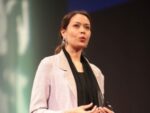 Kya Kim is Korean/American, born and raised in Japan. With an international background in Peace and Conflict Studies and Media, she worked as the first resident journalist at Transcend Media Service in Stadtschlaining Austria, under the guidance of Dr. Johan Galtung, Dr. Dietrich Fischer, and Antonio C. S. Rosa. After working as a global campaigner on post-Fukushima issues with Avaaz.org, she has dedicated the past several years to art and education as a tool for cross-cultural dialogue and peacebuilding. Kya is the Director of Peace Mask Project, an international nonprofit organization, and lectures at three universities in Kyoto, Japan while working as a member of the Editorial team for the International Network of Museums for Peace. You can contact her at: peacemaskproject@gmail.com
Kya Kim is Korean/American, born and raised in Japan. With an international background in Peace and Conflict Studies and Media, she worked as the first resident journalist at Transcend Media Service in Stadtschlaining Austria, under the guidance of Dr. Johan Galtung, Dr. Dietrich Fischer, and Antonio C. S. Rosa. After working as a global campaigner on post-Fukushima issues with Avaaz.org, she has dedicated the past several years to art and education as a tool for cross-cultural dialogue and peacebuilding. Kya is the Director of Peace Mask Project, an international nonprofit organization, and lectures at three universities in Kyoto, Japan while working as a member of the Editorial team for the International Network of Museums for Peace. You can contact her at: peacemaskproject@gmail.com
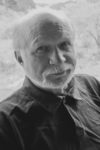 Robert Kowalczyk is a member of the TRANSCEND Network for Peace Development Environment. He is former Professor and Department Chair of the Department of Intercultural Studies in the School of Art, Literature and Cultural Studies of Kindai University, Osaka, Japan. Robert has coordinated a wide variety of projects in the intercultural field, and is currently the International Coordinator of Peace Mask Project. He has also worked in cultural documentary photography and has portfolios of images from Korea, Japan, China, Russia and other countries. He has been a frequent contributor to Kyoto Journal. Contact can be made through his website portfolio: robertkowalczyk.zenfolio.com.
Robert Kowalczyk is a member of the TRANSCEND Network for Peace Development Environment. He is former Professor and Department Chair of the Department of Intercultural Studies in the School of Art, Literature and Cultural Studies of Kindai University, Osaka, Japan. Robert has coordinated a wide variety of projects in the intercultural field, and is currently the International Coordinator of Peace Mask Project. He has also worked in cultural documentary photography and has portfolios of images from Korea, Japan, China, Russia and other countries. He has been a frequent contributor to Kyoto Journal. Contact can be made through his website portfolio: robertkowalczyk.zenfolio.com.
Tags: Culture of Peace, Peace art, Peacebuilding
This article originally appeared on Transcend Media Service (TMS) on 17 Aug 2020.
Anticopyright: Editorials and articles originated on TMS may be freely reprinted, disseminated, translated and used as background material, provided an acknowledgement and link to the source, TMS: Celebrating 20 Years of Peace Mask Project: An Interview with Director Kya Kim, is included. Thank you.
If you enjoyed this article, please donate to TMS to join the growing list of TMS Supporters.

This work is licensed under a CC BY-NC 4.0 License.
